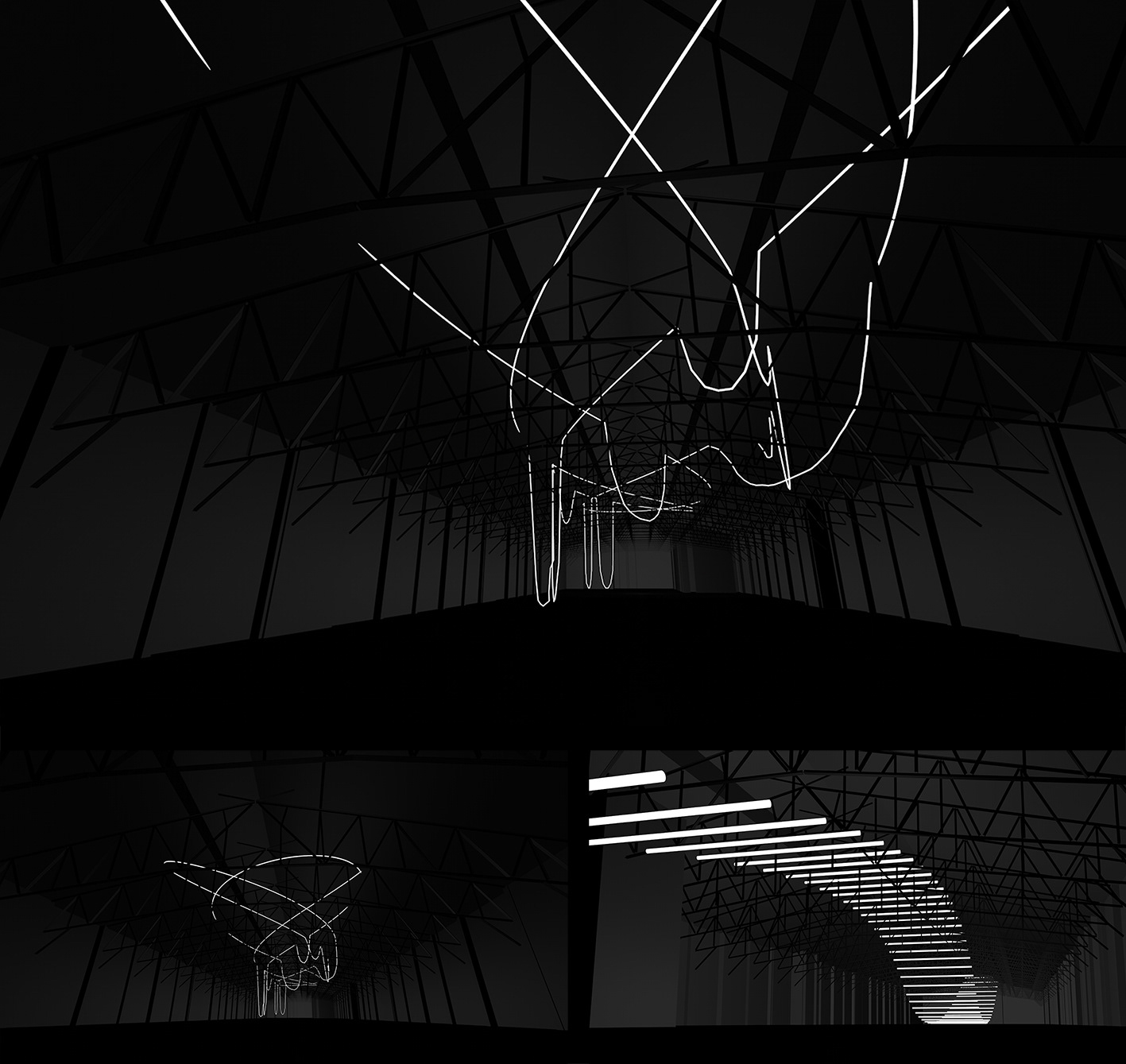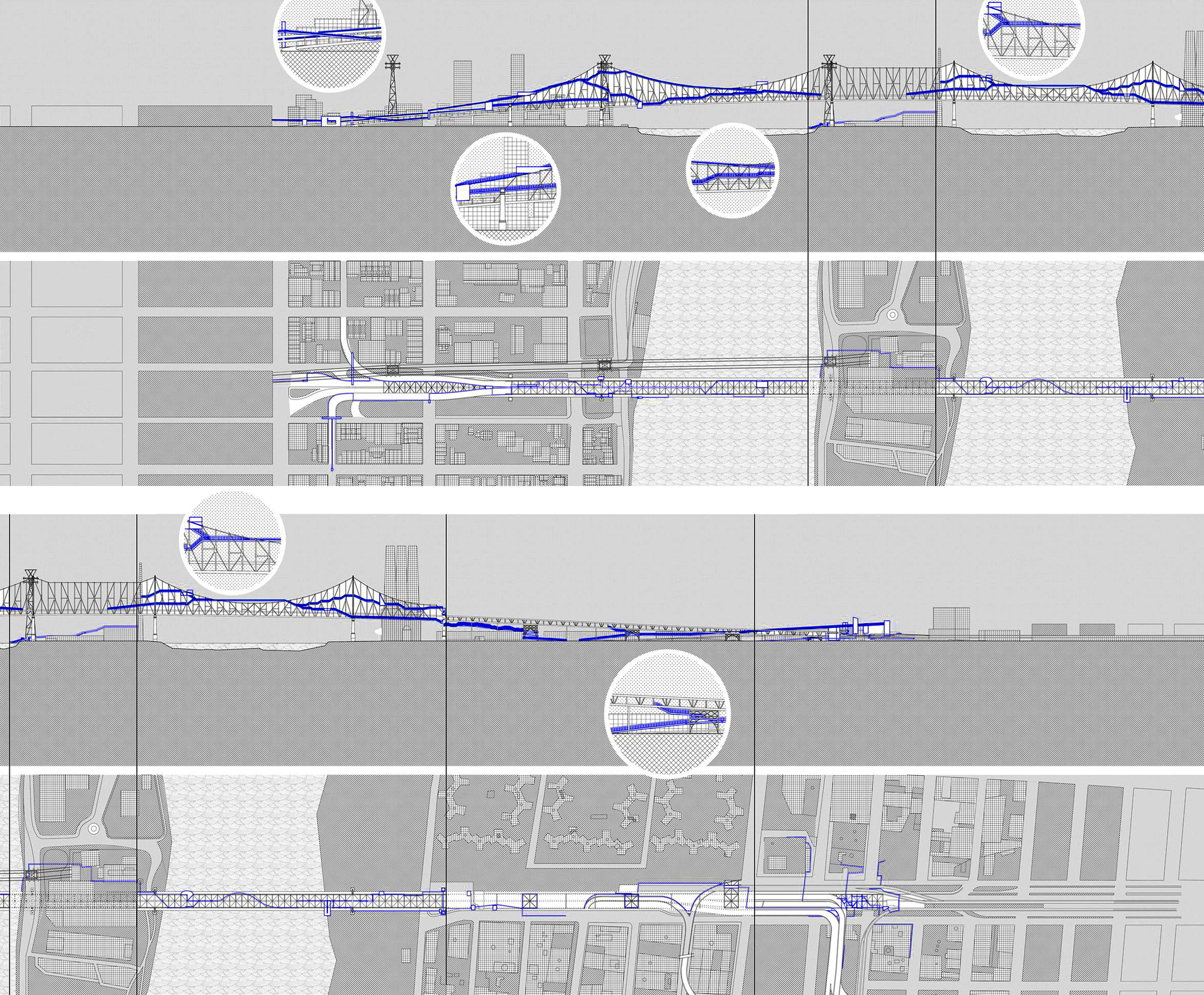Past & Future Proposals
Because all ideas and concepts are not thought to ever become a finalised product, or because when they are, they don’t always make it to this final phase. But it is about keeping those thoughts ready for future perspectives.
Selected work
Siulo by Rosalie Laurin, Gabrielle Laurin
Terres by Rosalie Laurin, Gabrielle Laurin
BT2020 by Rosalie Laurin
Lights by Rosalie Laurin, Laurent Dubuis
Derives by Rosalie Laurin
~
Siulo by Rosalie Laurin, Gabrielle Laurin, study for an outdoor artwork, 2020
We look at the pictures of the valley. We imagine that we are there: standing in the slope, motionless. We look at the mountain and observe its movement. The wind plays in the grass, it draws contour lines in the stretch of grass that rises before our eyes. The wind animates the valley with its gusts and thus it gives life to the landscape. Higher, a top is pitching peacefully, trying the keep the rhythm in the wind. The idea comes to us that the tree and the wind are talking, one is blowing while the other rustles. The landscape and the wind are intimately linked. We then imagine a flag, an object which also speaks with the wind. The flag flaps, it inflates, it floats and undulates, it twists and turns, it folds and stretches. The wind taps it and suddenly slaps it, then suddenly come to a rest.
In the course of history, when man plants a flag, he wants to signal his territorial appropriation. The first man to walk on the moon plants thus a flag. Who are we to think of appropriating the moon or the mountain? We wish to take here the opposite view on this symbol, to create an anti-banner. We imagine a flag-landscape: the inclusion of a dreamed landscape in a real landscape - a tribute paid to nature in its most humble way possible. Our ode is inspired by the paintings of Georgia O'Keeffe whose work wanders between lines of mountains and interior "faces" of flowers. Thus, the shapes on the flag draw a landscape evoking, in turn, the lines of the surrounding landscape and the macroscopic folds of flower petals. We wish to symbolise the possession of the nature by the nature.
The flag is conceived also as a rallying landmark for the hikers. It is visible from far with its bright colors chosen to contrast with the bright green of the highland grass, or the flashing blue of the wind-washed sky. Here, the hikers are invited to take a break, to look around, the flag offering a continuity between an artistic contemplation and the observation of the valley. Siulo is a borrowed name, it refers to the wind of the same name which blows in the region. A flag in homage to nature, to the valley.
A painting that rises only when inflated by the wind, in short, only when nature "makes" it visible for us.
Drawings courtesy of Gabrielle & Rosalie Laurin


Terres
by Rosalie Laurin, Gabrielle Laurin for le Domaine de Vizille, Vizille, France, 2020
Photocollages courtesy of Gabrielle & Rosalie Laurin
Like in legends; What if this park and those mountains were inhabited by a giant? To great domains, great masters, no? We imagine a giant made of earth and bark. Both heavy and voluminous, yet never would he crumple a leaf nor tear a blade of grass from the nature of which he is a part and which he protects. Magic spirit of the place, he combines a colossal presence with an airy delicacy. We let our thoughts wander a little further and we imagine that he had once chosen the open air area around the Grand Canal to install a washing line to dry his clothes in the sun. Still today when coming to the Domain, visitors are invited to discover the forgotten gigantic clothes hanging over the canal, testifying in filigree of the giant's lasting presence in the region.
The visitor contemplates the park, but the park is also watched over by the Giant and through his forgotten clothes he also observes the visitor. Thus, the nature all around through him is as well, inspecting the visitors. The relationship between the observer and the observed object is then reversed.
Terres gives its name to the simple geometrical shapes "drying" above the canal. The pieces of fabric or Terres are designed to be large enough to enter in dialogue with the vast locus of the park, like banners. Two elements seem to us important: that these Terres bear the imprint of the Domaine and that, in exchange, they enhance the beauty of the park. The imprint of the Domain will be created through the traditional process of dyeing. To observe closely the territory and to identify specific zones where to collect pigments, each dye giving its name to one of the Terres.
The solid shapes work in turn as frames and as backgrounds to magnify the Domain. The shapes guide the visitor's eye and give him a glimpse of selected fragments of the of the park. The color palette of the Terres contrasts with the green cameo of the park, in a complementary range of sienna and ocre revealing the buried (under ground) colors of the earth, exposing the hues of the depths in the air.
If the body of the proposal consists of the spatial installation, its heart remains in the legend of the delicate Giant. The tale which could be inspired by numerous local folklores over Europe, takes as an example the capacity of non-humans to live without endangering the fragile balance of their ecosystem.


BT2020 by Rosalie Laurin, fiction for a future projection (from the year 2020)
It's like this time, in the 2020s. They had found in the market gardens of Amiens, on the banks of the Ile aux fagots - I still remember the names, I know the area well, my mother's aunt had a shack not far from there, towards Flixecourt. Anyway... They had found something that everyone called the Totem Bust. I must admit, I find the name very limited. But I remember the first photo very precisely, because then obviously everyone rushed to make their own. They had even started to charge the entrance to the site. But still, the very first photo is the one that remained, the one that everyone saw. Of course it was everywhere, on the front page of every newspaper, on every screen. It was the time when information circulated faster than your shadow. They were calling it "viral", then there was a real virus and we stopped using this word everywhere, no holds barred. Anyway... the picture... At first you thought everything was normal, the riverside, the canal, the bank full of trees reflected on the water, the horn boat in the foreground. If I remember correctly it must have been early summer, the shades of green in the photo were rather bright. And then, right in the middle, "the thing". Let me tell you, it went down well in the press and then everyone quickly took up the terms: stupor, UFO, foreign body, extraterrestrial presence. Imagine, I was a kid at the time, the subject captivated me. The thing was as high as two adults standing and you could go around it with your arms, but you bet!, nobody dared to touch it. It's true that it looked a bit like a tree trunk or rather, several sections of tree trunks grafted onto one another. Hence their idea of a totem, of a spiritual monolith. If you ask me, I'm not sure that the descendants of the Objiwa of the Great Lakes appreciated the parallel. But trust me, the skin was too smooth, too shiny, too black to be a tree, even a weird one. Anyway, the incident doesn't end there. One day, they decided that the thing was dangerous, they even talked about evacuating Amiens. You can imagine the mess... It didn't take long. No more curious people and pictures. They set up a security perimeter, and there, well sheltered, everything went through: rays, samples, probes, electrodes. At that time, we still thought that we had to understand everything, to control everything. We called it science, technology. Well, that probably doesn't ring a bell with you. In any case, they didn't hit the nail on the head. And one morning, it was the beginning of autumn, on the photo of the riverside, the leaves of the trees would have had started to turn yellow. That morning, the thing disappeared. Fainted, nothing anymore. Well... It was other times. If you ask me, I don't think we'd ever have that today. Impossible. Everything is too slow, first of all it would take us a long time to realise that the thing has even appeared. And then we'd be three peelers to worry about it. But especially at the time there were too many waves everywhere. I tell you what, I believe that this thing was transplanted there from space through our own waves. There was a false contact somewhere in the galactic universe and it appeared here as quickly as it vanished. You see a short circuit? Well, the same thing. It's a good thing it wasn't 100,000 km long, that damn monolith.
Lights
by Rosalie Laurin and Laurent Dubuis, various studies, since 2015
Photocollages courtesy of Rosalie Laurin & Laurent Dubuis



Dérives by Rosalie Laurin, at ESA, Paris, France, 2013
Cities are speed machines, a city never sleeps. To imagine a suspended journey, "off-screen", which intermingles, which is full of detours, a path that dances. We become the "flâneur" of Walter Benjamin, we are invited to stroll and drift. The footbridge gives access to another rhythm, disconnected from the speed of the city, we can finally dissociate ourselves from it. And that gives the necessary distance to really look at it. From afar or rather as if we were far away. It becomes a setting, it finally stands still.
On the way, there are refuges, garden follies. We enter. Each refuge has a window and all the rest is built around to lead to the appropriate posture and height to look through it. The window becomes a frame and the outside a picture: a rectangle of tiles on a roof, the top of a tree, the surface of the river below. Photographs of patterns, fragments of a fixed city. They punctuate the course, like painting in a museum.
Photographs and drawings courtesy of Rosalie Laurin










